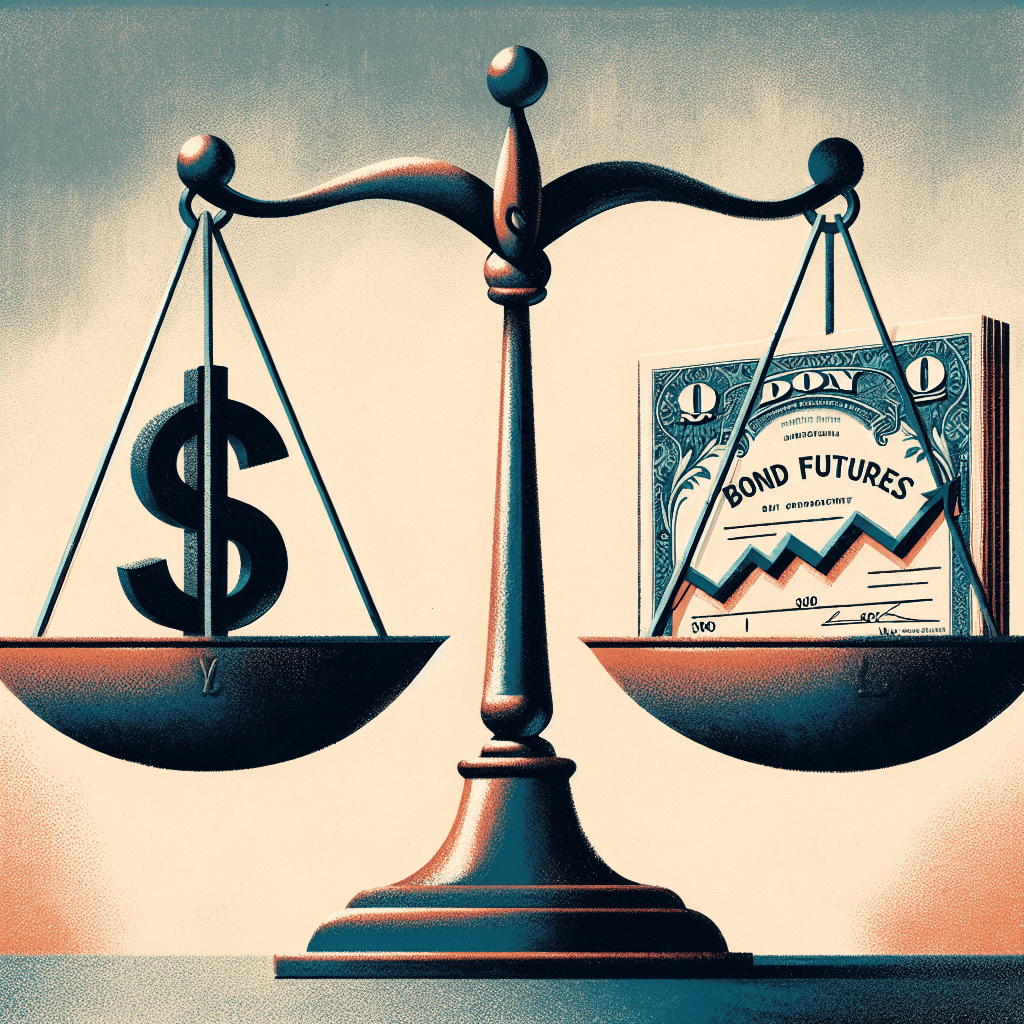“Amid Trump Trade Turmoil, Dollar Dips as Bond Futures Rise.”
Introduction
In the wake of growing uncertainty surrounding the so-called “Trump Trade,” the U.S. dollar has experienced a notable decline, prompting a corresponding rise in bond futures. This shift reflects investor apprehension about the sustainability of the economic policies and market optimism that initially surged following the election of President Donald Trump. As doubts emerge regarding the implementation and impact of proposed tax reforms, infrastructure spending, and deregulation, market participants are reassessing their positions, leading to a retreat from the dollar and a flight towards the relative safety of bonds. This dynamic underscores the volatility and unpredictability that have characterized financial markets in the era of Trump’s presidency, as stakeholders navigate the complex interplay of political developments and economic indicators.
Impact Of ‘Trump Trade’ Uncertainty On Global Markets
The global financial markets have been experiencing a notable shift as uncertainty surrounding the so-called ‘Trump Trade’ has led to a decline in the value of the U.S. dollar, while simultaneously providing a boost to bond futures. This phenomenon, which has captured the attention of investors and analysts alike, underscores the intricate interplay between political developments and economic indicators. As the world grapples with the implications of these changes, it is essential to understand the underlying factors contributing to this market behavior.
Initially, the ‘Trump Trade’ was characterized by a surge in the U.S. dollar and equities, driven by expectations of pro-growth policies under the Trump administration. These policies included tax cuts, deregulation, and increased infrastructure spending, which were anticipated to stimulate economic growth and inflation. Consequently, investors flocked to the dollar and equities, anticipating higher interest rates and robust economic performance. However, as time has progressed, the anticipated policies have faced numerous hurdles, leading to growing skepticism about their implementation and effectiveness.
This skepticism has been exacerbated by political uncertainties, including legislative gridlock and investigations into the administration’s activities. As a result, confidence in the ‘Trump Trade’ has waned, prompting a reassessment of the dollar’s strength. The decline in the dollar can be attributed to several factors, including diminished expectations for aggressive interest rate hikes by the Federal Reserve. With inflation remaining subdued and economic growth showing signs of moderation, the central bank has adopted a more cautious approach, further dampening the dollar’s appeal.
In contrast, bond futures have experienced a resurgence, benefiting from the uncertainty surrounding the ‘Trump Trade.’ As investors seek safe-haven assets amid political and economic ambiguity, bond markets have become increasingly attractive. The inverse relationship between bond prices and yields has led to a rally in bond futures, as lower yields make bonds more appealing to investors seeking stability. This shift in investor sentiment highlights the delicate balance between risk and reward in the current market environment.
Moreover, the global implications of the dollar’s decline and the rise in bond futures cannot be overlooked. A weaker dollar has far-reaching consequences for international trade and investment, as it affects the competitiveness of U.S. exports and the value of foreign earnings for multinational corporations. Additionally, emerging markets, which often rely on dollar-denominated debt, may experience relief from a weaker dollar, as it reduces the burden of debt repayments. However, this relief is tempered by the potential for increased volatility and capital outflows, as investors reassess their risk exposure.
In conclusion, the uncertainty surrounding the ‘Trump Trade’ has had a profound impact on global markets, manifesting in the decline of the U.S. dollar and the rise of bond futures. This dynamic reflects the complex interplay between political developments, economic indicators, and investor sentiment. As the world continues to navigate these challenges, it is crucial for market participants to remain vigilant and adaptable, recognizing that the landscape is constantly evolving. By understanding the factors driving these market movements, investors can better position themselves to navigate the uncertainties that lie ahead, ensuring that they are prepared for whatever the future may hold.
How Dollar Declines Influence Bond Futures
The recent decline of the U.S. dollar has sparked significant interest among investors and analysts, particularly in the context of the so-called ‘Trump Trade’ uncertainty. This phenomenon, characterized by market reactions to policies and statements from former President Donald Trump, has had a profound impact on various financial instruments, including bond futures. Understanding the intricate relationship between the dollar’s performance and bond futures is crucial for investors seeking to navigate these turbulent waters.
To begin with, the value of the U.S. dollar is a critical factor in the global financial system, influencing everything from commodity prices to international trade balances. When the dollar weakens, it often leads to a ripple effect across various markets. In the case of bond futures, a declining dollar can make U.S. bonds more attractive to foreign investors. This is because a weaker dollar means that foreign investors can purchase U.S. bonds at a relatively lower cost in their local currencies, potentially leading to increased demand for these securities.
Moreover, the decline in the dollar can also impact inflation expectations, which are a key determinant of bond prices. A weaker dollar can lead to higher import prices, contributing to inflationary pressures. In response, investors might anticipate that the Federal Reserve will adjust interest rates to counteract inflation, which can influence bond yields and, consequently, bond futures. As bond yields rise, bond prices typically fall, but the increased demand from foreign investors can offset this effect, leading to a complex interplay between these factors.
Furthermore, the uncertainty surrounding the ‘Trump Trade’ adds another layer of complexity to this scenario. During Trump’s presidency, markets often reacted sharply to his policy announcements and tweets, creating volatility and uncertainty. This unpredictability can lead to fluctuations in the dollar’s value, as investors attempt to gauge the potential impact of policy changes on the U.S. economy. In such an environment, bond futures can serve as a hedge against currency risk, providing investors with a tool to manage their exposure to the dollar’s volatility.
In addition to these factors, it is important to consider the broader economic context in which these dynamics are unfolding. The global economy is interconnected, and developments in one region can have far-reaching implications. For instance, economic growth in emerging markets can influence demand for U.S. bonds, while geopolitical tensions can lead to shifts in investor sentiment. These factors, combined with the dollar’s performance and ‘Trump Trade’ uncertainty, create a complex landscape for bond futures.
In conclusion, the decline of the U.S. dollar amid ‘Trump Trade’ uncertainty has significant implications for bond futures. The interplay between currency value, inflation expectations, and investor sentiment creates a dynamic environment that requires careful analysis and strategic decision-making. As investors navigate these challenges, understanding the relationship between the dollar and bond futures is essential for making informed investment choices. By considering the various factors at play, investors can better position themselves to capitalize on opportunities and mitigate risks in this ever-evolving financial landscape.
Analyzing The Relationship Between Currency Fluctuations And Bond Markets
The intricate relationship between currency fluctuations and bond markets is a subject of perennial interest to economists and investors alike. Recently, the decline of the U.S. dollar amid uncertainties surrounding the so-called ‘Trump Trade’ has brought this relationship into sharp focus, particularly as it pertains to the uplift in bond futures. To understand this dynamic, it is essential to explore the underlying factors contributing to the dollar’s depreciation and how these, in turn, influence bond market movements.
The ‘Trump Trade’ refers to the market trends that emerged following the election of Donald Trump as President of the United States, characterized by expectations of fiscal stimulus, tax cuts, and deregulation. Initially, these policies were anticipated to spur economic growth, leading to a stronger dollar and rising interest rates. However, as uncertainties regarding the implementation and effectiveness of these policies have grown, the dollar has experienced a decline. This depreciation can be attributed to several factors, including geopolitical tensions, trade policy unpredictability, and mixed economic data, which have collectively eroded investor confidence in the dollar’s strength.
As the dollar weakens, it exerts a significant influence on bond markets, particularly U.S. Treasury bonds. A declining dollar often leads to lower yields on these bonds, as foreign investors find them more attractive due to the currency’s reduced value. Consequently, this increased demand for bonds drives up their prices, resulting in an uplift in bond futures. Moreover, the inverse relationship between bond prices and yields means that as bond prices rise, yields fall, which can have broader implications for the economy, including lower borrowing costs for consumers and businesses.
Furthermore, the interplay between currency fluctuations and bond markets is also shaped by expectations of future monetary policy. A weaker dollar can lead to speculation that the Federal Reserve may adopt a more dovish stance, potentially delaying interest rate hikes to support economic growth. This anticipation can further bolster bond prices, as investors adjust their portfolios in response to changing interest rate expectations. Additionally, the global nature of financial markets means that currency movements can have ripple effects across international bond markets, influencing investment decisions and capital flows worldwide.
In this context, it is crucial to consider the role of investor sentiment and market psychology. The uncertainty surrounding the ‘Trump Trade’ has heightened market volatility, prompting investors to seek safe-haven assets such as bonds. This flight to safety can amplify the impact of currency fluctuations on bond markets, as risk-averse investors prioritize capital preservation over higher returns. Consequently, the relationship between the dollar’s decline and the uplift in bond futures is not merely a matter of economic fundamentals but also reflects the complex interplay of market perceptions and expectations.
In conclusion, the recent decline of the U.S. dollar amid ‘Trump Trade’ uncertainties underscores the intricate relationship between currency fluctuations and bond markets. As the dollar weakens, it influences bond prices and yields, driven by factors such as foreign investment demand, monetary policy expectations, and investor sentiment. Understanding this dynamic is essential for investors and policymakers alike, as it provides valuable insights into the interconnectedness of global financial markets and the potential implications for economic stability and growth. As such, continued analysis of these relationships remains vital in navigating the complexities of today’s economic landscape.
The Role Of Political Uncertainty In Financial Market Volatility

The financial markets are often sensitive to political developments, and the recent decline of the U.S. dollar amid uncertainty surrounding the so-called ‘Trump Trade’ serves as a pertinent example. This phenomenon underscores the intricate relationship between political uncertainty and market volatility, a dynamic that investors and analysts must continuously navigate. The ‘Trump Trade’ refers to the market movements that followed the election of Donald Trump as President of the United States in 2016, characterized by expectations of tax cuts, deregulation, and infrastructure spending. These anticipated policies initially led to a surge in the dollar and equities, as investors bet on accelerated economic growth. However, as political realities have unfolded, the sustainability of these expectations has come into question, leading to fluctuations in the financial markets.
Political uncertainty can manifest in various forms, including changes in leadership, policy shifts, and geopolitical tensions. Each of these factors can influence investor sentiment and, consequently, market behavior. In the case of the ‘Trump Trade,’ the initial optimism was tempered by legislative challenges and geopolitical concerns, which have contributed to the dollar’s decline. This depreciation of the dollar has, in turn, had a ripple effect across other asset classes, notably lifting bond futures. As the dollar weakens, U.S. exports become more competitive, potentially boosting economic growth. However, the flip side is that a weaker dollar can also lead to higher import prices, contributing to inflationary pressures.
The interplay between the dollar’s value and bond futures is particularly noteworthy. When the dollar declines, it often leads to lower yields on U.S. Treasury bonds, as foreign investors seek to hedge against currency risk. This increased demand for bonds drives up their prices, resulting in higher bond futures. Moreover, the uncertainty surrounding the ‘Trump Trade’ has prompted investors to seek safe-haven assets, further bolstering bond markets. This flight to safety is a common reaction during periods of political uncertainty, as investors prioritize capital preservation over higher returns.
In addition to the direct impact on currency and bond markets, political uncertainty can also influence broader economic indicators. For instance, business investment decisions may be delayed or altered in response to unclear policy directions, affecting economic growth prospects. Similarly, consumer confidence can be swayed by political developments, influencing spending patterns and, by extension, economic activity. These factors contribute to a complex feedback loop, where political uncertainty and market volatility reinforce each other.
To navigate this environment, investors and policymakers must remain vigilant and adaptable. Diversification strategies can help mitigate risks associated with political uncertainty, while policymakers can strive to provide clear and consistent communication to reduce market anxieties. Furthermore, understanding the historical context of political events and their market implications can offer valuable insights for future decision-making.
In conclusion, the decline of the dollar amid ‘Trump Trade’ uncertainty highlights the significant role that political factors play in financial market volatility. As the global landscape continues to evolve, the interplay between politics and markets will remain a critical area of focus for investors and analysts alike. By recognizing the potential impacts of political developments, market participants can better position themselves to navigate the challenges and opportunities that arise in this ever-changing environment.
Strategies For Investors Amid Dollar Decline And Bond Market Shifts
The recent decline of the U.S. dollar, coupled with the uncertainty surrounding the so-called “Trump Trade,” has created a complex landscape for investors seeking to navigate the shifting bond market. As the dollar weakens, bond futures have experienced an uplift, presenting both challenges and opportunities for strategic investment. Understanding the interplay between these financial elements is crucial for investors aiming to optimize their portfolios in this evolving environment.
To begin with, the depreciation of the dollar can be attributed to a variety of factors, including geopolitical tensions, fluctuating interest rates, and market skepticism regarding the sustainability of policies associated with the Trump administration. This uncertainty has led to a reevaluation of the “Trump Trade,” a term that encapsulates the market’s initial optimism about pro-growth policies such as tax cuts and deregulation. As confidence wanes, investors are increasingly seeking refuge in safer assets, thereby influencing the bond market.
In this context, bond futures have emerged as a focal point for investors. The inverse relationship between bond prices and yields means that as bond prices rise, yields fall, making bonds an attractive option for those seeking stability amid currency volatility. The uplift in bond futures suggests that investors are hedging against potential risks associated with the dollar’s decline. Consequently, this shift has implications for investment strategies, particularly for those focused on balancing risk and return.
For investors, one potential strategy is to diversify their portfolios by incorporating a mix of domestic and international bonds. This approach can mitigate the impact of currency fluctuations while capitalizing on the relative strength of foreign currencies. Additionally, considering bonds with varying maturities can provide a buffer against interest rate changes, offering a more resilient investment framework.
Moreover, investors might explore opportunities in sectors that traditionally benefit from a weaker dollar, such as commodities and export-driven industries. A depreciating dollar can enhance the competitiveness of U.S. exports, potentially boosting revenues for companies in these sectors. By strategically allocating resources to such industries, investors can leverage the dollar’s decline to their advantage.
Furthermore, it is essential for investors to remain vigilant and informed about macroeconomic indicators and policy developments. Monitoring interest rate decisions by the Federal Reserve, for instance, can provide insights into future currency movements and bond market trends. Staying abreast of geopolitical events and trade negotiations is equally important, as these factors can significantly influence market dynamics.
In addition to these strategies, investors should consider the role of technology and data analytics in enhancing decision-making processes. Advanced analytical tools can offer valuable insights into market trends and potential risks, enabling investors to make more informed choices. By leveraging technology, investors can better anticipate market shifts and adjust their strategies accordingly.
In conclusion, the decline of the dollar and the uplift in bond futures present a multifaceted challenge for investors. By adopting a diversified approach, focusing on sectors poised to benefit from currency movements, and utilizing technology to inform decision-making, investors can navigate this complex landscape with greater confidence. As the financial environment continues to evolve, staying informed and adaptable will be key to successfully managing investments amid the uncertainties of the “Trump Trade” and the broader market shifts.
Historical Context: Currency Movements During Political Transitions
The historical context of currency movements during political transitions offers a fascinating lens through which to examine the recent decline of the U.S. dollar amid uncertainties surrounding the so-called ‘Trump Trade.’ Political transitions, particularly in major economies like the United States, often lead to significant fluctuations in currency values as markets react to anticipated policy changes. The ‘Trump Trade,’ a term coined to describe the market rally following Donald Trump’s 2016 election victory, was initially characterized by expectations of tax cuts, deregulation, and infrastructure spending. These anticipated policies were believed to stimulate economic growth, thereby strengthening the dollar. However, as political realities set in and uncertainties about policy implementation grew, the dollar’s trajectory began to shift.
Historically, currency markets are highly sensitive to political developments, as they can signal changes in economic policy that impact interest rates, inflation, and overall economic stability. During political transitions, investors often reassess their portfolios, leading to increased volatility in currency markets. In the case of the ‘Trump Trade,’ initial optimism gave way to skepticism as legislative hurdles and geopolitical tensions emerged, causing the dollar to weaken. This decline can be attributed to a combination of factors, including doubts about the administration’s ability to deliver on its economic promises and broader global economic dynamics.
As the dollar weakened, bond futures experienced a lift, reflecting a shift in investor sentiment. Bond markets are typically seen as safe havens during periods of uncertainty, and the inverse relationship between bond prices and yields means that as demand for bonds increases, their yields decrease. The rise in bond futures suggests that investors were seeking refuge from the volatility in currency markets, anticipating that the Federal Reserve might adopt a more cautious approach to interest rate hikes in response to the dollar’s decline. This interplay between currency and bond markets underscores the interconnectedness of global financial systems and the complex ways in which political transitions can influence economic indicators.
Moreover, the historical context of currency movements during political transitions highlights the role of central banks in managing market expectations. Central banks, such as the Federal Reserve, play a crucial role in stabilizing currency markets by adjusting monetary policy in response to economic conditions. During periods of political uncertainty, central banks may intervene to prevent excessive currency fluctuations that could destabilize the economy. In the case of the ‘Trump Trade,’ the Federal Reserve’s actions were closely watched by investors, as any indication of a shift in monetary policy could have significant implications for both the dollar and bond markets.
In conclusion, the decline of the dollar amid ‘Trump Trade’ uncertainty and the corresponding lift in bond futures can be understood within the broader historical context of currency movements during political transitions. These periods are often marked by heightened volatility as markets adjust to new political realities and reassess economic forecasts. The interplay between currency and bond markets during such times reflects the complex dynamics at play, as investors navigate the uncertainties inherent in political change. Understanding these historical patterns provides valuable insights into the potential impacts of political transitions on global financial markets, highlighting the importance of careful analysis and strategic decision-making in times of uncertainty.
Future Outlook: Navigating Financial Markets In Uncertain Political Climates
The financial markets are often a reflection of the prevailing political climate, and recent developments have underscored this intricate relationship. The dollar’s decline amid uncertainty surrounding the so-called ‘Trump Trade’ has become a focal point for investors and analysts alike. This phenomenon, characterized by market movements in response to policies and rhetoric associated with former President Donald Trump, has once again come into the spotlight, influencing various asset classes, including bond futures.
In the wake of political developments, the dollar has experienced a notable decline. This depreciation can be attributed to a confluence of factors, including shifting expectations regarding U.S. fiscal and monetary policies. Investors are grappling with the potential implications of policy changes, which have introduced a degree of uncertainty into the markets. As a result, the dollar’s weakening has provided a boost to bond futures, as investors seek refuge in safer assets amid the prevailing uncertainty.
The relationship between the dollar and bond futures is complex, yet it is rooted in fundamental economic principles. A weaker dollar often makes U.S. assets more attractive to foreign investors, as it effectively lowers the cost of purchasing these assets in other currencies. Consequently, this increased demand can drive up the prices of U.S. bonds, leading to a rise in bond futures. Moreover, the current environment of uncertainty has heightened the appeal of bonds as a safe haven, further supporting their upward trajectory.
Transitioning to the broader implications of these market movements, it is essential to consider the potential impact on global financial stability. The interconnectedness of global markets means that fluctuations in the U.S. dollar and bond futures can have ripple effects across the world. Emerging markets, in particular, are sensitive to changes in U.S. monetary policy and currency valuations. A weaker dollar can alleviate some pressure on these economies by reducing the burden of dollar-denominated debt, yet it can also introduce volatility as investors reassess their risk exposure.
Furthermore, the uncertainty surrounding the ‘Trump Trade’ has prompted a reevaluation of investment strategies. Market participants are increasingly focused on diversification and risk management, seeking to navigate the unpredictable landscape. This shift in strategy underscores the importance of adaptability in financial markets, as investors must remain vigilant and responsive to changing conditions.
In light of these developments, central banks and policymakers face the challenge of maintaining economic stability while addressing the concerns of market participants. The Federal Reserve, in particular, plays a crucial role in shaping market expectations through its monetary policy decisions. As the central bank navigates the delicate balance between supporting economic growth and curbing inflation, its actions will undoubtedly influence the trajectory of the dollar and bond futures.
In conclusion, the decline of the dollar amid ‘Trump Trade’ uncertainty and the subsequent rise in bond futures highlight the intricate interplay between political developments and financial markets. As investors and policymakers grapple with the challenges posed by this environment, the importance of adaptability and strategic foresight cannot be overstated. By understanding the underlying dynamics and remaining attuned to shifts in the political landscape, market participants can better position themselves to navigate the complexities of financial markets in uncertain political climates.
Q&A
1. **What is the ‘Trump Trade’?**
The ‘Trump Trade’ refers to the market movements and economic expectations following the election of Donald Trump as President, characterized by anticipated tax cuts, deregulation, and infrastructure spending.
2. **Why is the dollar declining?**
The dollar is declining due to uncertainty surrounding the implementation and effectiveness of Trump’s proposed economic policies.
3. **How does the dollar’s decline affect bond futures?**
A declining dollar often leads to increased demand for U.S. bonds, as they become cheaper for foreign investors, thus lifting bond futures.
4. **What are bond futures?**
Bond futures are contracts that obligate the buyer to purchase a bond at a predetermined price on a specified future date.
5. **What factors contribute to the uncertainty of the ‘Trump Trade’?**
Factors include political challenges, delays in policy implementation, and doubts about the economic impact of the proposed measures.
6. **How does uncertainty impact financial markets?**
Uncertainty can lead to increased volatility, risk aversion, and shifts in investment strategies, affecting currency values, stock prices, and bond yields.
7. **What are the potential long-term effects of a declining dollar?**
Long-term effects may include increased competitiveness of U.S. exports, higher import costs, potential inflationary pressures, and shifts in global investment flows.
Conclusion
The decline of the dollar amid uncertainty surrounding the “Trump Trade” has led to a boost in bond futures. This situation reflects investor concerns about the sustainability and clarity of economic policies associated with the Trump administration, prompting a shift towards safer assets like bonds. As the dollar weakens, it underscores the market’s cautious stance and the potential volatility in currency and financial markets driven by political and economic unpredictability.





